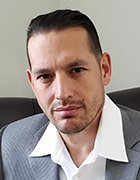
agsandrew - Fotolia
Workspot VDI key to engineering firm's pandemic planning
Southland Industries was in the process of transitioning to a virtual desktop service when COVID-19 emerged. In this Q&A, Israel Sumano discusses how the outbreak accelerated those plans.
Like many companies, Southland Industries is working to accelerate its virtualization plans in the face of the coronavirus pandemic.
The mechanical engineering firm, which is based in Garden Grove, Calif., and has seven main offices across the U.S., has been using the Workspot Workstation Cloud virtual desktop service. Combined with Microsoft Azure Cloud, Workspot's service enables engineers to build design-intensive work at home and enables Southland to keep pace as technology advances. When COVID-19 emerged, the company was transitioning users in the mid-Atlantic states to virtual desktops.
Israel Sumano, senior director of infrastructure at Southland Industries, recently spoke about making the move to virtual desktops and the challenges posed by the current public health crisis.
How did your relationship with Workspot first begin?
 Israel Sumano
Israel Sumano
Israel Sumano: We were replicating about 50 terabytes across 17 different locations in the U.S. real-time, with real-time file launches. It became unsustainable. So over the last five years, I've tested VDI solutions -- Citrix, [VMware] Horizon, other hosted solutions, different types of hardware. We never felt the performance was there for our users.
When Workspot came to us, I liked it because we were able to deploy within a week. We tested it on on-prem hardware, we tested it on different cloud providers, but it wasn't until we had Workspot on [Microsoft] Azure that we were comfortable with the solution.
For us to build our own GPU-enabled VDI systems [needed for computing-intensive design work], we probably would have spent about $4 million, and they would have been obsolete in about six years. By doing it with Microsoft, we were able to deploy the machines and ensure they will be there and upgradeable. If a new GPU comes out, we can upgrade to the new GPU and it won't be much cost to us to migrate.
How has your experience in deploying Workspot been so far? What challenges have you met?
Sumano: It was a battle trying to rip the PCs from engineers' hands. They had a lot of workstations [and] they really did not want to give them up. We did the first 125 between October 2017 and February 2018. … That pushed back the rest of the company by about a year and a half. We didn't get started again until about October of 2019. By that time, everyone had settled in, and they all agreed it was the best thing we've ever done and we should push forward. That's coming from the bottom up, so management is very comfortable now doing the rest of the company.
How did you convince workers that the virtualization service was worthwhile?
Sumano: They were convinced when they went home and were able to work, or when they were in a hotel room and they were able to work. When they were at a soccer match for their kids, and something came up that needed attention right away, they pulled out their iPads and were able … to manipulate [designs] or check something out. That's when it kicked in.
In the past, when they went to a job site, [working] was a really bad experience. We invested a lot of money into job sites to do replication [there].
[With Workspot,] they were able to pick up their laptops, go to the job site and work just like they were at the office.
The novel coronavirus has forced companies to adopt work-at-home policies. What is Southland's situation?
Sumano: We have offices in Union City [California], which is Marin County, and they were ordered to stay in place, so everyone was sent home there. We just got notice that Orange County will be sent home. Our Las Vegas offices have also been sent home.
Our job sites are still running, but having this solution has really changed the ability for these engineers to go home and work. Obviously, there's nothing we can do about the shops -- we need to have people on-hand at the shop, [as] we're not fully automated at that level.
On the construction site, we need guys to install [what Southland has designed]. Those are considered critical by the county. They're allowed to continue work at the job sites, but everybody from the offices has been set home, and they're working from home.
We hadn't done the transition for the mid-Atlantic division to Workspot. We were planning on finishing that in the next 10 weeks. We are now in a rush and plan on finishing it by next Friday. We're planning on moving 100 engineers to Workspot, so they're able to go home.
How has it been, trying to bring many workers online quickly?
Sumano: I've been doing this a long time. I've implemented large virtual-desktop and large Citrix environments in the past. It's always been a year to a year-and-a-half endeavor.
We are rushing it for the mid-Atlantic. We'd like to take about 10 weeks to do it -- to consolidate servers and reduce footprint. We're skipping all those processes right now and just enacting [virtualization] on Azure, bringing up all the systems as-is and then putting everyone onto those desktops.
Has the new remote-work situation been a strain on your company's infrastructure?
Sumano: The amount of people using it is exactly the same. We haven't heard any issues about internet congestion -- that's always a possibility with more and more people working from home. It's such a small footprint, the back-and-forth chatter between Workspot and your desktop, that it shouldn't be affected much.
What's your level of confidence going forward, given that this may be a protracted situation?
Sumano: We're very confident. We planned on being 100% Azure-based by December 2020. We're well on track for doing that, except for, with what's happening right now, there was a bit of a scramble to get people who didn't have laptops [some] laptops. There's a lot of boots on the ground to get people able to work from home.
Most of our data is already on Azure, so it's a very sustainable model going forward, unless there's a hiccup on the internet.
Editor's note: This interview has been edited for clarity and length.




_searchsitetablet_520X173.jpg)


